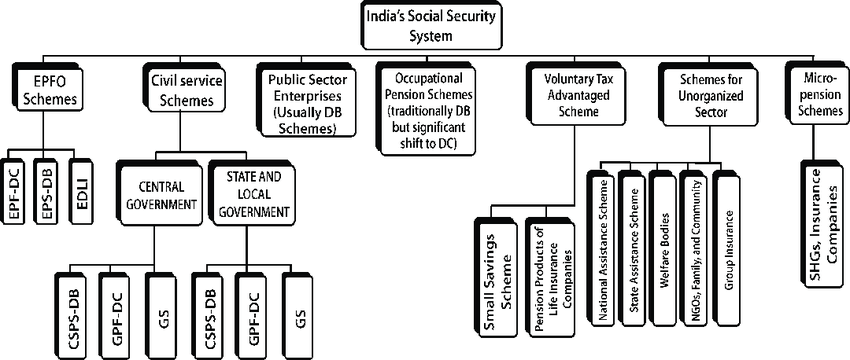
The International Labour Organization defines social security as “the protection that a society provides to individuals and households to ensure access to health care and to guarantee income security, particularly in cases of old age, unemployment, illness, invalidity, work injury, maternity, or loss of a breadwinner.”
It is typically a right granted to people for financial and social security during illness, disability, or old age. It is recognized as a fundamental human right in both the UN and ILO conventions. The Universal Declaration of Human Rights (UDHR) also recognizes all social security rights. It supports the recipients’ rights to family safety and support, a reasonable standard of living, and appropriate access to healthcare.
People have social security to fall back on in difficult circumstances. Social security is necessary for social welfare. In times of need, it serves as a buffer against all dangers. It raises the standard of living for people by assisting in the emancipation of millions of people from poverty.
Following independence, current social security policies in India were developed and implemented. However, even though the majority of the workforce (about 93% in 2004–2005) was employed in the unorganized sector, its wages were too meagre and restricted to workers in the industry organized alone (self-employed or casual workers). Most importantly, the Eleventh Five-Year Plan recognizes the need to guarantee social security for all, particularly those working in the unorganized sector (2007-12). Through its Directive Principles of State Policy, the Indian Constitution provides social security for both organized and unorganized workers with strength and spirit. After extensive industrialization, social security legislation was created as part of industrial policy. During the British era, some social security benefits in the form of Acts for organized workers employed in large industrial units (factories, mills, etc.) were also passed. However, significant social laws were not passed until after independence.
India needs social security due to the following factors: rising population levels; increasing poverty; increasing inequality; increasing unemployment; and rising numbers of people working in the unorganized sector. Besides these, dangers and risks at work; privatization; an ageing population; and an increase in migration.
The following are some citations for significant social legislation and social security policies affecting industrial workers:
The Workmen’s Compensation Act, 1923; Provident Funds and Miscellaneous Provisions Act, 1952; The Employees State Insurance (ESI) Act, 1948; The Maturity Benefit Act, 1961 (amended in 1976); The Payment of Gratuity Act, 1972; Universal Contributory Health Insurance Act, 2004; The Aam Admi Bima Yojana, 2008; The National Health Insurance Scheme, 2007; The Indira Gandhi National Old Age Pension Scheme.

The following are some examples of programmes and schemes to help the tribal people, the rural poor, and the urban poor:
Five-Year Plans and Community Development Projects (CDPs); Food for Work and Antyodaya Yojana, 1977; Integrated Rural Development Programme (IRDP), 1976; National Rural Employment Programme (NREP), 1977; Jawahar Rojgar Yojana (JRY), 1980; Mahatma Gandhi National Rural Employment Guarantee Scheme (MNREGS), 2006; Integrated Tribal Development Plan; Swarna Jayanti Gram Swrozgar Yojana, 1999; Swarna Jayanti Shahri Swarozgar Yojana; Sarva Shiksha Abhiyan, 2001; Indira Awas Yojana; Rajiv Awas Yojana, 2009; Pradhan Mantri Gram Sadak Yojana; Bharat Nirman, 2005; Janani Suraksha Yojana, 2011; Pradhan Mantri Swastha Suraksha Yojana; Total Sanitation Programme or Nirmal Bharat Abhiyan, 2012.
As a result, while a sizable portion of the organized sector workforce has benefited from legally required and budget-funded social security benefits since independence, the majority of the unorganized workforce (less than 10% of the total unorganized workforce) has been left out.
According to the World Labour Report from 2000, India’s public sector spent only 1.8 percent of the country’s GDP on social security, compared to 4.7 percent in Sri Lanka and 3.6 percent in China. The eligibility requirements are too strict, as many vulnerable people are left out. Using the below poverty line (BPL) criterion to extend social security to unorganized workers is a flimsy and inappropriate strategy. Despite not falling into the poor category in India, about 55% of the population is still at risk.
In addition, most unorganized workers struggle with a lack of knowledge about social welfare and security programmes. The argument has been made that the state’s social welfare programs have suffered due to globalization. The condition frequently encourages globalization rather than allowing it. Because of this, it will undoubtedly affect the state’s welfare policies and character.
Social security and welfare are closely related, but they serve different purposes. Social security refers both to a state of mind and a concrete reality. Its primary goal is to ensure income security as a necessary step toward a form of social and psychological well-being. On the other hand, social welfare is defined as “the outcome of ownership of goods, positions in life, and supply of services to help him to live in wholesome contentment and communication with others in the group.”

A collection of institutional or individual services offered by the government or non-profit groups to victims of disabilities, disorganization, delinquency, poverty, etc., is referred to as social welfare in a more general sense.


I like what you guys are up too. Such intelligent work and reporting! Keep up the superb works guys I’ve incorporated you guys to my blogroll. I think it will improve the value of my site 🙂
I am impressed with this site, real I am a fan.
Those are yours alright! . We at least need to get these people stealing images to start blogging! They probably just did a image search and grabbed them. They look good though!